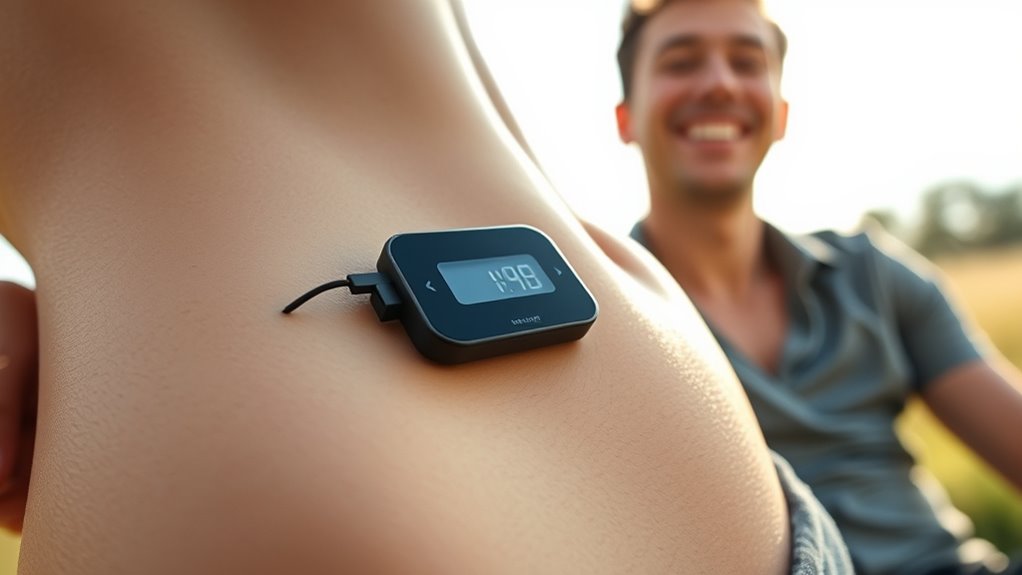An artificial pancreas system frees you from constant blood sugar checks and manual insulin doses by automatically monitoring your glucose levels and adjusting insulin delivery in real time. It combines sensors, an insulin pump, and smart algorithms to keep your blood sugar stable, so you don’t have to think about it constantly. This technology streamlines management and offers more freedom. Keep exploring to discover how these advancements can improve your daily life.
Key Takeaways
- Automates insulin delivery based on real-time glucose data, reducing the need for manual blood sugar testing.
- Continuous glucose monitoring with sensor calibration ensures accurate, reliable data for safe insulin management.
- Wireless connectivity and smartphone integration allow remote monitoring and adjustments, decreasing constant device interaction.
- Advanced control algorithms adapt to individual patterns, maintaining stable blood sugar levels with minimal user intervention.
- Overall system integration simplifies diabetes management, freeing users from frequent finger pricks and manual insulin calculations.

An artificial pancreas system is a groundbreaking technology designed to help people with diabetes manage their blood sugar levels more effectively. This innovative device combines continuous glucose monitoring with automated insulin delivery, reducing the need for constant finger pricks and manual adjustments. As you start using an artificial pancreas, you’ll notice how seamlessly it integrates into your daily routine, offering a greater sense of freedom and control.
One of the key challenges in developing an effective artificial pancreas is ensuring accurate sensor calibration. The sensor, which measures your glucose levels in real-time, must provide precise data for the system to function correctly. If the sensor isn’t properly calibrated, the device might deliver too much or too little insulin, risking dangerous swings in blood sugar. Thankfully, modern systems feature advanced calibration protocols that make this process straightforward, often requiring just a few calibration points during initial setup. These calibration routines help you maintain reliable sensor readings, which is essential for the system’s overall safety and performance.
Device integration is another critical aspect of the artificial pancreas. The system’s components—glucose sensor, insulin pump, and control algorithm—must work together smoothly. You’ll find that today’s systems are designed with user-friendly interfaces and wireless connectivity, making device integration seamless. The sensor communicates wirelessly with the insulin pump, allowing the system to adjust insulin delivery automatically based on your current glucose levels. This integration minimizes manual input, reducing the chances of user error and allowing you to focus on your day rather than constant monitoring. Many systems also connect to smartphone apps, giving you easy access to data and alerts, and enabling remote monitoring if needed.
The real magic happens through the system’s control algorithms, which analyze sensor data and determine the ideal insulin dose in real time. This automation means you no longer need to manually calculate doses or worry about forgetting to check your levels periodically. Instead, the device continuously adapts to your body’s changing needs, providing a more stable blood sugar profile. Over time, the system learns your patterns, further refining its responses to your lifestyle and physiology. Additionally, advancements in sensor technology contribute to more accurate and reliable readings, enhancing the overall effectiveness of the artificial pancreas system.
Frequently Asked Questions
How Does the Artificial Pancreas Differ From Traditional Insulin Pumps?
You’ll find that an artificial pancreas differs from traditional insulin pumps by offering sensor integration and automated regulation. It continuously monitors your blood sugar levels with a sensor and automatically adjusts insulin delivery, reducing the need for manual input. This system mimics a healthy pancreas more closely, providing more precise control, fewer blood sugar swings, and greater freedom from constant monitoring, making diabetes management less burdensome and more effective.
What Are the Common Challenges in Developing Artificial Pancreas Technology?
Imagine you’re developing an artificial pancreas, but sensor calibration remains tricky, causing inaccurate readings that impact insulin delivery. You also face device miniaturization challenges, trying to fit complex tech into a compact, user-friendly system. These hurdles make consistent performance and user comfort difficult. Overcoming sensor calibration issues and creating smaller, more reliable devices are critical steps in advancing artificial pancreas technology, ensuring it’s effective and accessible for diabetics.
Can the Artificial Pancreas Adapt to Sudden Changes in Activity or Stress?
Yes, the artificial pancreas can adapt to sudden changes in activity or stress through real-time adjustments. It continuously monitors your glucose levels and responds quickly to fluctuations caused by stress or physical activity. This proactive approach helps manage stress effectively and keeps your blood sugar stable. By automating insulin delivery based on real-time data, the system guarantees you stay balanced even during unpredictable situations, reducing the risk of complications.
What Is the Cost and Insurance Coverage for an Artificial Pancreas System?
When it comes to the cost and insurance coverage for an artificial pancreas system, it’s a mixed bag. Insurance coverage varies widely, with some plans covering significant portions, while others offer limited support. The cost comparison shows it can be expensive upfront, but long-term benefits might outweigh initial expenses. You should check with your insurer to understand your coverage options and potential out-of-pocket costs, so you’re not caught off guard.
How Long Does It Take to See Benefits After Starting Artificial Pancreas Therapy?
You’ll typically see benefits like improved blood sugar stabilization within a few days to a week after starting artificial pancreas therapy. During this time, your healthcare team will monitor your progress and make therapy adjustment timelines as needed. As your body adjusts, you’ll notice fewer lows and highs, making daily management easier. Keep in mind, individual responses vary, so stay in close contact with your provider for ideal results.
Conclusion
So, it’s almost funny how a device designed to mimic your pancreas can suddenly free you from constant monitoring. As you go about your day, this system seamlessly adjusts your insulin levels, making life feel a little more normal. It’s like life’s little coincidence — just when you think managing diabetes will always be a challenge, technology steps in right when you need it most, turning what once seemed impossible into everyday ease.









